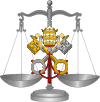Ecclesiastical crime
An ecclesiastical crime is a crime (delictum) related to the clergy where the crime is against canon law. Compare civil law.
 |
| Part of a series on the |
| Canon law of the Catholic Church |
|---|
|
Jus antiquum (c. 33-1140)
Jus novum (c. 1140-1563) Jus novissimum (c. 1563-1918) Jus codicis (1918-present) Other |
|
Sacraments
Sacred places
Sacred times |
|
|
Supreme authority, particular churches, and canonical structures Supreme authority of the Church
Supra-diocesan/eparchal structures
|
|
|
Temporal goods (property) |
|
Canonical documents |
|
Procedural law Pars statica (tribunals & ministers/parties)
Pars dynamica (trial procedure)
Election of the Roman Pontiff |
|
Legal practice and scholarship
Academic degrees Journals and Professional Societies Faculties of canon law
Canonists |
|
|
The crime of Simony is the ecclesiastical crime of paying for offices or positions in the hierarchy of a church. The crimes of Schism[1] and Heresy are also ecclesiastical crimes.
Older examples include "perjury", the breaking of a promissory oath (contractual promises made by oath or pledge of faith), and this was treated as an ecclesiastical crime. Some crimes have or have had both an ecclesiastical and a civil element to the crime; suicide and witches[2] are counted here.
Financial and donation related
The term is also specifically used today for misappropriation of donation monies. In the International Bulletin of Missionary Research,[3] January 2009, David B. Barrett, Todd M. Johnson, Peter F Crossing, study titled, Christian World Communions: Five Overviews of Global Christianity, AD 1800–2025 they show that "Ecclesiastical crime" is growing at 5.77% per annum and in mid-2009 is estimated to be USD$27 billion on a total "Giving to Christian causes" of USD$410 Billion. Unchecked this crime will be valued at USD$65 Billion by 2025[4]
See also
- Ecclesiastical courts
- Ecclesiastical ordinances
- Ecclesiastical prison
- Canon law
- Sacrament of Penance
References
- The deep wound of schism in the archdiocese, Archbishop Raymond L. Burke - schism in context of the St. Stanislaus Kostka Church (Saint Louis)
- Malleus Maleficarum - discusses who tries witches: balancing "Heresy" and "temporal injuries"
- International Bulletin of Missionary Research, Issue 33:1, January 2009
- Archived 2011-07-19 at the Wayback Machine (PDF) Extract from International Bulletin of Missionary Research, Vol. 33, No. 1